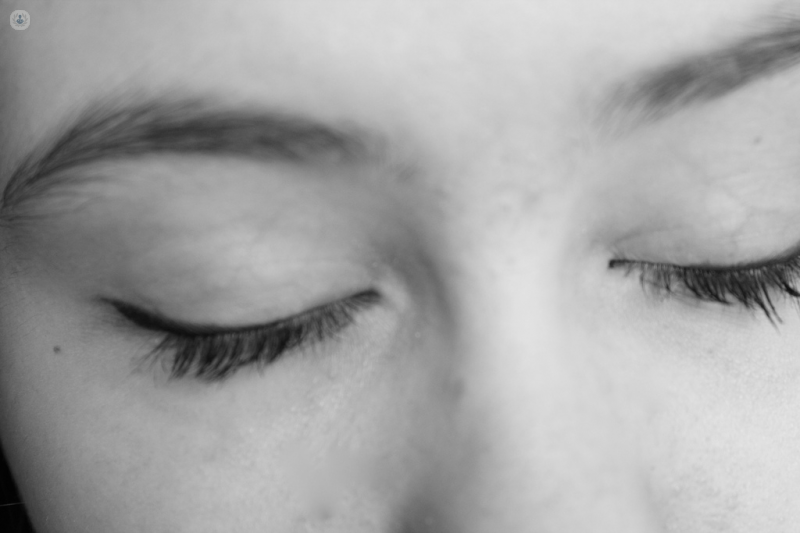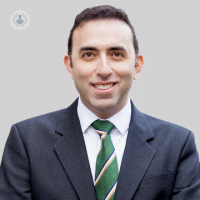What is blepharospasm?
Written by:The eyelids are a part of our anatomy that perhaps we take for granted. When you think about it, however, their importance cannot be overstated: they protect our eyes from dust and foreign debris, keep the eye from drying out, and close the eye during sleep. A number of conditions can affect the eyelids. Among these is benign essential blepharospasm. Expert ophthalmologist and oculoplastic surgeon Mr Daniel Ezra explains:

What is blepharospasm?
Blepharospasm is a condition that affects the muscles that control the eyelids, making them close involuntarily. It often manifests as rapid, frequent blinking, the eyes forcing themselves shut, being unable to open the eye (apraxia), or a combination of these symptoms. Blepharospasm can have a serious impact on the patient’s life, particularly affecting their vision.
In around 30% of patients other facial muscles are affected too, leading to involuntary tongue, mouth and neck movements. Occasionally, the larynx (voicebox) also suffers, giving the patient a hoarse or whispering voice.
While there is currently no cure for blepharospasm, many treatment options exist. Most patients can gain control over their symptoms with the right combination of medical and surgical treatments.
What causes blepharospasm?
Blepharospasm is a complex condition. Genetics are believed to play a role, with many patients reporting a family history of both blepharospasm and chronic eye irritation (usually blepharitis or dry eyes). This irritation is thought to lead to a maladaptive reflex response, which causes the blinking reflex (which exists to protect the eye) to get out of control and overwhelm normal eyelid function.
In recent research at Moorfields Eye Hospital, London, we have found evidence that an abnormality exists in the nerve layer of the corneal epithelium, along with decreased sensitivity in the surface of the eye in blepharospasm patients. This is similar to sensory abnormalities found in patients with other dystonias (neurological movement disorders in which the muscles contract uncontrollably, resulting in twisting and abnormal postures). This suggests that issues with the sensory information relayed to and from the brain could contribute to dystonia.
How is blepharospasm treated?
First, it is important to identify and eliminate anything that is irritating the surface of the eye. The usual causes are dry eye and blepharitis, but a full slit lamp biomicroscope examination can help rule out other causes, such as Sjorgren’s syndrome, thyroid eye disease and herpetic keratopathy.
Next, the overactive muscle groups are carefully injected with botulinum toxin (Botox). Each individual patient has a different pattern of spasm, so the doctor will tailor the injection programme specifically to the patient.
Additionally, some patients may be found to have ptosis (drooping eyelid) or excess upper eyelid skin, which may require surgical correction.
It is important to get treatment from medical specialists with expertise in blepharospasm management. The Moorfields Eye Hospital is a renowned centre of excellence in the treatment of this condition, treating several hundreds of patients every year.
Is botulinum toxin treatment safe?
There is no risk of botulism or food poisoning from Botox treatment, and we are confident that it poses no risk to the patient’s general health, based on three decades of using this treatment at Moorfields. Furthermore, the treatment is not known to harm women who are pregnant or breastfeeding, or their babies, although some patients prefer to wait until after they have given birth or weaned their infants before having the treatment.
I have tried Botox, but it is not working. What else can I do?
Sometimes patients become resistant to Botox after many years of successful treatment, while in other cases the treatment does not work from the start. Other options include:
- Changing to a different strain of botulinum toxin – this can overcome an acquired resistance to a particular strain.
- Oral medications – several types of treatment exist, which target the brain to overcome the sensory problem. Doctors may suggest trying these, although they may not be effective for all patients.
- Blepharoplasty surgery – this removes excess upper eyelid skin and muscle
- Orbicularis myectomy – removal of the muscle fibres closest to the eyelid margin, which can weaken the muscles that close the eye.
- Brow suspension surgery – involves internal suspension of the eyelid unit to the brow. This can be particularly effective for patients with apraxia.
Botox therapy can also be beneficial in the treatment of facial nerve paralysis, helping to relieve twitching caused by the nerve misfiring. It can also be highly effective in improving facial symmetry.
I have extensive experience treating all of these conditions in my capacity as clinical lead for the botulinum toxin service at Moorfields.
To book an appointment with Mr Daniel Ezra today, simply visit his Top Doctors profile.


